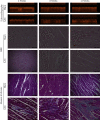Cholecystokinin Expression in the Development of Myocardial Hypertrophy
- PMID: 34497680
- PMCID: PMC8405328
- DOI: 10.1155/2021/8231559
Cholecystokinin Expression in the Development of Myocardial Hypertrophy
Abstract
Background: Expression of cholecystokinin is found in myocardial tissues as a gastrointestinal hormone and may be involved in cardiovascular regulation. However, it is unclear whether there is an increase in cholecystokinin expression in myocardial hypertrophy progression induced by abdominal aortic constriction. The study is aimed at exploring the relationship between cholecystokinin expression and myocardial hypertrophy.
Methods: We randomly divided the 70 Sprague-Dawley rats into two groups: the sham operation group and the abdominal aortic constriction group. The hearts of rats were measured by echocardiography, and myocardial tissues and blood were collected at 4 weeks, 8 weeks, and 12 weeks after surgery. Morphological changes were assessed by microscopy. The cholecystokinin expression was evaluated by immunochemistry, Western blotting, quantitative real-time polymerase chain reaction, and enzyme-linked immunosorbent assay.
Results: The relative protein levels of cholecystokinin were significantly increased in the abdominal aortic constriction groups compared with the corresponding sham operation groups at 8 weeks and 12 weeks. The cholecystokinin mRNA in the abdominal aortic constriction groups was significantly higher than the time-matched sham operation groups. Changes in the left ventricular wall thickness were positively correlated with the relative protein levels of cholecystokinin and the mRNA of cholecystokinin.
Conclusions: The development of myocardial hypertrophy can affect the cholecystokinin expression of myocardial tissues.
Copyright © 2021 Zhongshu Han et al.
Conflict of interest statement
The authors declare that they have no competing interests.
Figures





Similar articles
-
Cholecystokinin Expression in the Development of Postinfarction Heart Failure.Cell Physiol Biochem. 2017;43(6):2479-2488. doi: 10.1159/000484454. Epub 2017 Oct 31. Cell Physiol Biochem. 2017. PMID: 29130944
-
[Change of short-chain acyl-CoA dehydrogenase in heart failure after myocardial infarction in rats and the intervention of aerobic exercise].Zhonghua Wei Zhong Bing Ji Jiu Yi Xue. 2019 Feb;31(2):172-177. doi: 10.3760/cma.j.issn.2095-4352.2019.02.010. Zhonghua Wei Zhong Bing Ji Jiu Yi Xue. 2019. PMID: 30827304 Chinese.
-
[C/EBP homologous protein-mediated endoplasmic reticulum stress-related apoptosis pathway is involved in abdominal aortic constriction-induced myocardium hypertrophy in rats.].Sheng Li Xue Bao. 2009 Apr 25;61(2):161-8. Sheng Li Xue Bao. 2009. PMID: 19377828 Chinese.
-
[Effect of tashinone on nitric oxide synthase in hypertrophic cardiomyocyte of rats suffered abdominal aorta constriction].Zhongguo Zhong Yao Za Zhi. 2008 Jun;33(12):1446-50. Zhongguo Zhong Yao Za Zhi. 2008. PMID: 18837353 Chinese.
-
Overexpression of miR-142-3p improves mitochondrial function in cardiac hypertrophy.Biomed Pharmacother. 2018 Dec;108:1347-1356. doi: 10.1016/j.biopha.2018.09.146. Epub 2018 Oct 4. Biomed Pharmacother. 2018. PMID: 30372837
Cited by
-
Cholecystokinin Octapeptide Promotes ANP Secretion through Activation of NOX4-PGC-1α-PPARα/PPARγ Signaling in Isolated Beating Rat Atria.Oxid Med Cell Longev. 2022 Jun 20;2022:5905374. doi: 10.1155/2022/5905374. eCollection 2022. Oxid Med Cell Longev. 2022. PMID: 35770043 Free PMC article.
References
MeSH terms
Substances
LinkOut - more resources
Full Text Sources
